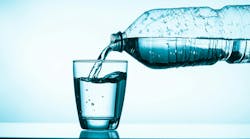‘Tis the season! The impact of bubbly (champagne and prosecco) on oral health
Though New Year’s Eve has come and gone, I’ll still enjoy some bubbly occasionally, as I’m sure many of your patients do. Champagne and prosecco are two of the world's most celebrated sparkling wines. Each offer distinct flavors, production methods, and acidity levels. A core element influencing their taste and mouthfeel is their pH level, which measures acidity. Say it isn’t so!
Understanding the pH of these wines not only enhances appreciation but also informs choices regarding pairing and consumption. Since I like the occasional bubbly drink, and I know I’m not alone, I dug into learning more about these wines.
pH and acid measurements
As clinicians, we know the pH scale ranges from 0 to 14, with 7 being neutral. Values below 7 indicate acidity, while those above signify alkalinity. Most wines fall between 2.5 and 4.5 on this scale, meaning they’re acidic. This acidity is central to the flavor, preservation, and overall balance of the wine.1
Originating from France's Champagne region, champagne is primarily produced from chardonnay, pinot noir, and pinot meunier grapes. The region's cool climate contributes to high acidity levels in the grapes. Champagne typically exhibits a pH ranging from 2.5 to 3.0, indicating significant acidity. This high acidity contributes to champagne's crispness and aging potential, offering flavors such as lemon, green apple, and toasty notes from extended yeast contact.2,3
Hailing from Italy's Veneto region, prosecco is predominantly made from the glera grape. The production method, known as the tank method, results in a wine with soft, large bubbles, and a fresh, fruity profile. Prosecco generally has a pH around 3.25 to 3.5, making it slightly less acidic than champagne. This moderate acidity, combined with high residual sugar levels, imparts a sweet taste with notes of green apple, pear, and white flowers.2.3
The acidity in champagne and prosecco significantly influences their flavor profiles and pairing versatility. Champagne's higher acidity and fine bubbles make it an excellent match for rich, fatty foods such as oysters, fried chicken, and creamy cheeses, as the acidity cuts through the fat and cleanses the palate. Prosecco's moderate acidity and fruit-forward character pair well with light fare such as prosciutto, melon, sushi, and salads, complementing the delicate flavors without overwhelming them.
Dental considerations for champagne and prosecco
It should come as no surprise that while the acidity in these sparkling wines contributes to their appeal, it can pose challenges for dental health. Acidic beverages can erode tooth enamel over time, leading to sensitivity and decay. Prosecco, with a pH around 3.25 and high sugar content, has been associated with a condition colloquially known as "prosecco teeth," characterized by enamel erosion and increased cavity risk.
Similarly, champagne's high acidity can contribute to dental erosion if consumed excessively. Adding a mimosa to the mix introduces orange juice, with a pH ranging between 3.3 and 4.2, which can increase the risk of teeth troubles. Orange juice's acidity varies based on factors such as the type of oranges, their ripeness, and whether the juice is freshly squeezed or processed.
Freshly squeezed orange juice is generally more acidic, with a pH closer to 3.3 and 3.5. Store-bought versions, often altered by pasteurization and added ingredients, typically have a slightly higher pH around 4.0. This acidity gives orange juice its signature tartness and enhances its preservative qualities. Another favorite, from personal experience, is the French 75, a cocktail with a story as charming as its taste. The earliest version is said to have originated at Harry’s New York Bar in Paris. Made with gin, champagne, lemon juice, and simple syrup, it’s an enchanting mix, though I can feel enamel breakdown. On the bright side, at least the gin has a pH around 7; there’s a little balance for you!
Champagne and prosecco, while both delightful sparkling wines, differ notably in their pH levels and resulting acidity. Champagne's higher acidity offers a crisp, sharp profile, ideal for pairing with rich foods, while prosecco's moderate acidity and sweeter notes make it versatile for light dishes and casual sipping. As we’re mindful of their acidity, throwing in a little water cleanse is advised. Let’s celebrate, look ahead, and embrace new beginnings, and perhaps top it off with a splash of bubbly!
References
- Puckette M. Understanding the acidity in wine. Wine Folly. https://winefolly.com/deep-dive/understanding-acidity-in-wine/
- Hunt MC. Prosecco vs. champagne: what’s the difference? Total Wine & More. November 8, 2021. https://www.totalwine.com/discover/learn/champagne-vs-prosecco
- Kaia. The difference between champagne and prosecco: a comprehensive guide. Wine Mixture. March 14, 2024. https://www.winemixture.com/archives/7393
About the Author

Anne O. Rice, BS, RDH, CDP, FAAOSH
Anne O. Rice, BS, RDH, CDP, FAAOSH, founded Oral Systemic Seminars after over 35 years of clinical practice and is passionate about educating the community on modifiable risk factors for dementia and their relationship to dentistry. She is a certified dementia practitioner, a longevity specialist, a fellow with AAOSH, and has consulted for Weill Cornell Alzheimer’s Prevention Clinic, FAU, and Atria Institute. Reach out to Anne at anneorice.com.


